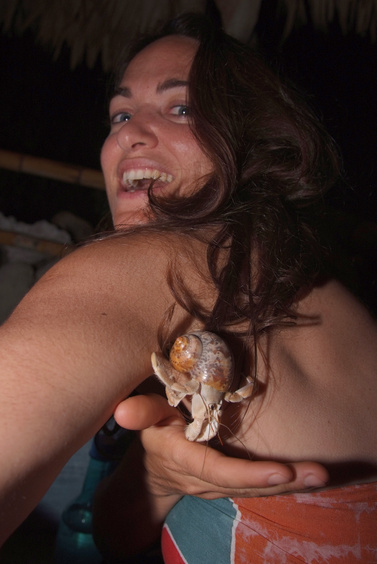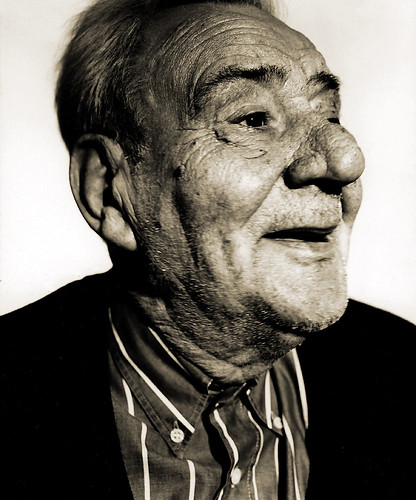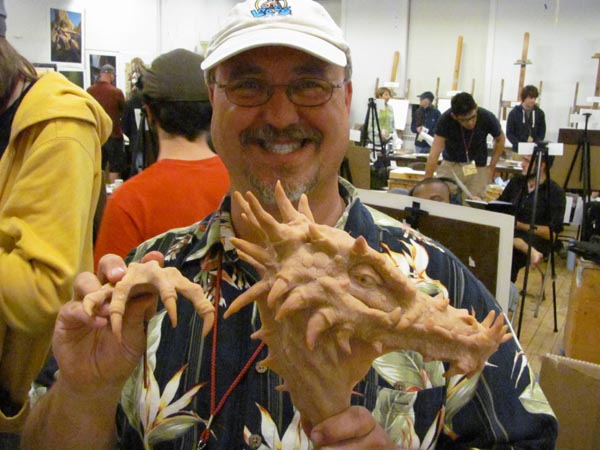- sex excellence
- Feb 19, 2011
-

Satisfaction Guranteed
|
The Badage boys are back in town
Akbar
Akbar, a powerful vampire, was burnt when the Mother and Father, Akasha and Enkil, were put into the sun. He resides in Antioch, in search of the Mother and Father, and leaves his victims on the steps of the Temple.
Akbar threatens to kill Pandora unless Marius allows him to see and drink from the ancient couple. He drains Pandora to near death before Marius allows him to see the Mother and Father, and is later destroyed by Akasha when he attempts to drink from her.

Azim
Azim was one of the older vampires. He ruled as a god for a thousand years in a secret temple in the Himalayas, where those who went to worship him never returned alive.
He conducted disturbing rituals and entices Pandora to participate in them in return for Marius' location (when Marius gets trapped in the ice after Akasha awakens).
Akasha spares him during her worldwide slaughter, but for a purpose. She sees him as the ultimate symbol of vampire evil and explodes his body in front of human witnesses.

Benji
A spirited boy of twelve, Benji was bought from a nomadic Arab tribe by Sybelle's brother Fox to care for Sybelle, which Benji loved to do. Benji was the genius of the tribe, able to read English, Hebrew and Arabic, and was bought from the tribe under the terms of a long-term lease of bondage for which Fox paid Benji's father five thousand dollars.
Benji prayed for a demon to take his soul if only to save Sybelle from her violent brother, Fox. His prayers were answered (in a way) when Armand (after going into the sun) killed Fox. Benji, along with Sybelle, become Armand's mortal children, and he his later made a vampire by Marius.

Daniel Molloy
Daniel was the recorder of Louis' confession that later became the story Interview with the Vampire. Born in 1955, Daniel comes across Armand in 1975, after he had recorded Louis' story.
He becomes Armand's mortal companion, but conflicts drive them apart. Armand continually refuses Daniel's requests for immortality.
Daniel turns to alcohol and becomes a mortal recipient of the dream of the twins. In 1985, Armand gives Daniel (who is dying) immortal life. He survives Akasha's worldwide slaughter of vampires.

Druid Vampire (God of the Grove)
The Druid Vampire, also known as the God of the Grove, was kept in an oak tree by the Druids to preside over their harvest and to ensure the fertility of their land. He was badly burnt when Akasha and Enkil were placed in the sun, and as a result of his weakened state, the Druids went in search for another god.
The Druids abduct Marius and return him to their god, who subsequently makes Marius a vampire. He is destroyed by the Druids when he tries to accompany Marius in search of reasons as to why so many vampires where burnt.

Synopsis
The brand-new bestselling series from the authors of the phenomenal multi-million-selling Left Behind books. Now in paperback!
Here is the first in the Biblically inspired series, The Jesus Chronicles, which brings to life the story of Jesus, told in the voices of those who knew and loved him best-the Gospel writers John, Mark, Matthew, and Luke.
In this volume, readers will discover John's story, a thrilling account of the life of the man who came to fulfill the prophecies of the Old Testament and to save all of humankind-and the disciple who was the last eyewitness to Jesus' glory. Readers will experience firsthand the creation of the Gospel of John as well as the Book of Revelation-Scripture that still has profound meaning for the world 2,000 years later.
-Publishers Weekly.

Elder
An ancient Egyptian vampire, the Elder was the guardian of Akasha and Enkil prior to Marius. He was the cause of vampires everywhere being burnt (himself included), when he placed the ancient couple in the sun.
He does this to test the legend that the preservation or destruction of Akasha and Enkil is the determinant in the survival of the vampire race.
When Marius comes to remove the ancient couple from the Elder's care, the Elder becomes enraged and is killed by Akasha.

Eric
Eric was made a vampire by Maharet around BC1000 at the mortal age of thirty. He survives Akasha's worldwide slaughter due to his immortal age of three thousand years and is one of the immortals that gather at Sonoma to stand against Akasha.

Flavius
Flavius is a one-legged Greek mortal slave who Pandora falls in love with in Antioch. He becomes Pandora's companion and protector even after she is made a vampire.
To the disgust of Marius, Pandora makes Flavius a vampire as he lay on his deathbed riddled with disease. He was forty years old.
When Marius discovers what Pandora has done, he sends Flavius away. Before he left, Flavius thanked Pandora for the immortality she gave him.

Laurent
Laurent is a vampire Baby Jenks meets during Akasha's worldwide slaughter of vampires. He is killed during this event. (He may or may not be the same Laurent from Armand's first Parisian coven — this is unclear.

Madeleine
Madeleine was a Parisian doll maker who Claudia chose to be her mother and protector when Claudia feared Louis would leave her for Armand.
She was killed by Armand's coven, together with Claudia, the same year she was given immortal life. She had lost a child near Claudia's age when Louis made her a vampire, in 1862. Madeleine was the first vampire made by Louis.

Magnus
Magnus, the maker of Lestat, gave himself immortality during the 1400s when he trapped a vampire and stole blood from it. He chose to make Lestat a vampire because of his courage.
On the same night he made Lestat a vampire, during the year 1780, he destroyed himself in a fire, leaving Lestat alone to discover and learn about his immortality.

The Woop-Town Supper
There was might in the whole world of the same face deers even when the metro man dances in the moon light and continues to splash fish in the water in an attempt to play some ball.

The Dark saucepan
Also known as the spiked black man of the Ackentosh desert. He used to go out in the desert for thousands of years and would come back.Althought his head is made out of two different war melons. His uper body has more of an Italian style hear-doo

The Jenikens Chronicle
Also know as the Master of Supper in the nether regions. His head head would be imploded if the crisp the crops during the Badage civil wars. The Akasha used to use the gamers rear end soer weapons because the butter on the boot would have even more then the yearsd of the yatke.

The Master of Might
The Nabonidus Chronicle is an ancient Babylonian text, part of a larger series of Babylonian Chronicles incribed in cuneiform script on clay tablets. It deals primarily with the reign of Nabonidus, the last king of the Neo-Babylonian Empire, covers the conquest of Babylon by the Persian king Cyrus the Great and ends with the start of the reign of Cyrus's son Cambyses, spanning a period from 556 BC to some time after 539 BC. It provides a rare contemporary account of Cyrus's rise to power and is the main source of information on this period;[1] Amélie Kuhrt describes it as "the most reliable and sober [ancient] account of the fall of Babylon."[2]

The essence of destruction
Although he may be just one of these old factioned faction. The master of wisom used tp bein the legue of the slit babied mammothes. It is unsure to why the health of such a large gigantic spepas uses such large and strange men.

The Roaming Swordman
He is thought to combat large spiked black zombies who use baked potatoes as a lube to make their eyes work ffaster. It was unsure why he would take such risks for only the amount of the same young hill billy uses hte sweat of a large
antelope and once they do, the large bird uses its pheromones to lure the large one with the old man happy.

The Captain of Akentoish
While employed by the Ministry of Culture in Paris, where she remained between 1981 and 1986, she produced her first novel, Le Livre des Nuits in 1985. It won six French Literary Prizes as well as the Scott Moncrieff Translations Prize in English. The reception of the book established her as a significnt new author.
In some Akasha tribes he was only a legend. That he hooked a large snail frm the young womans breast.Although his name was never more then the last siluhette, he uses the same sunrise radical to those who use hand cream.

The Nasty Banquote
She was born in Châteauroux in 1954. She remained there for eighteen months. During her childhood, with her three brothers and sisters, she moved from city to city, depending on the assignments her sub-prefect father received.
In 1976 she was awarded a Master of Philosophy by the Sorbonne, Paris, and in 1978 went on to complete an MA in philosophy and aesthetics at Université de Paris X - Nanterre. There, too, she completed a doctorate in philosophy in 1981. During those years she studied with a teacher she admires, Emmanuel Levinas, and her work focussed on the notion of asceticism in Christian mysticism.

Work
He uses the same humans as the one whpo produced the sweat y but also fat men of the large bablionial ground of which the man with the square and hte strange heart. He would cry 'Why are there latino in my huron'.

quote:Essential Reading
Carradice I, & Price M.J., Coinage in the Greek World, London 1988.
Sellwood, D. 'Minting' in D. Strong and D. Brown Roman Crafts, London 1976, pp.63-73
Catalogues & Reference Works (Some have very useful introductions)
*Burnett A., Amandry M., Rippolès P.P., Roman Provincial Coinage, London 1992.
*Callataÿ F. de., L'histoire des guerres Mithridatiques vue par les monnaies, Louvain-la-Neuve 1997.
Houghton A., Coins From the Seleucid Empire from the Collection of Arthur Houghton, New York 1983.
Lindgen H.C. & Kovacs F.L., I Ancient Bronze Coins of Asia Minor and the Levant, California 1985.
Lindgen H.C. & Kovacs F.L., II Ancient Greek Bronze Coins: European Mints, California 1989.
Lindgen H.C. & Kovacs F.L., III Ancient Bronze Coins from the Lindgren Collection, California 1993.
Metcalf W.E., The Silver Coinage of Cappadocia, Vespasian-Commodus, New York 1996.
Newell E.T., The Coinage of the Eastern Seleucid Mints from Seleucus I to Antiochus III, New York 1978 (reprint).
Newell E.T., The Coinage of the Western Seleucid Mints from Seleucus I to Antiochus III, New York 1977 (reprint).
*Price, M.J., Coinage in the Name of Alexander the Great and Philip Arrhidaeus, London 1991.
SNG British Museum I, The Black Sea, London 1993.
SNG Copenhagen
*SNG von Aulock (Asia Minor mints)
Secondary Literature: Monographs
Balmuth, M.S. Hacksilber to Coinage: New Insights into the Monetary History of the Near East and Greece, New York 2001.
Burnett A., Wartenberg U., & Witschonke R. (edd.), Coins of Macedonia and Rome: Essays in Honour of Charles Hersh, London 1998.
Butcher K., Roman Provincial Coins, Lonson 1988.
Carradice I., Greek Coins, London 1995.
Figuera T., The Power of Money: Coinage and Politics in the Athenian Empire, Pennsylvania 1998.
Grierson P. Numismatics, Oxford 1975.
Harl K.W., Civic Coins and Civic Politics, California 1987.
Head B., Historia Nummorum, 2nd ed. Oxford 1911/67.
Hill G.F., Coins of Ancient Sicily, London.
Hill G.F., Historical Greek Coins, London.
Howgego C., Ancient History from Coins.
Jenkins G.K., Ancient Greek Coins, 2nd ed London 1990.
Jones J.M., A Dictionary of Ancient Greek Coins, London 1986.
Kraay C.M., Archaic and Classical Greek Coins, London 1976.
Kraay C.M., Coins of Ancient Athens, Newcastle 1968.
*Martin T.R., Sovereignty and Coinage in Classical Greece, 1885.
Meadows, A. and K. Shipton Money and its Uses in the Ancient Greek World Oxford 2001.
Melville-Jones J.R., Testimonia Numaria, London 1993.
Milne J.G., Greek Coinage, Oxford 1931.
Mørkholm O., Early Hellenistic Coinage, Cambridge 1991.
Nash D., Coinage in the Celtic World, London 1987.
Oikonomides A.N., The Coins of Alexander the Great, Chicago 1981.
Penn R.G., Medicine on Ancient Greek and Roman Coins, London 1994.
Plant R., Greek Coin Types and Their Identification, London 1979.
Ramage, A. and Craddock, P. King Croesus' Gold: Excavations and the History of Gold Refining, London 2000.
Roberts W.R., The Ancient Boeotians and the Coinage of Boeotia, Chicago 1974.
Rutter, N.K., Greek Coinage, Aylesbury 1983.
Rutter, N.K., The Greek Coinages of Southern Italy and Sicily, London 1997.
Rutter, N.K. Historia Nummorum, Italy, London 2001.
Seltman C., Athens, its Hitsory and Coinage, Chicago 1974.
Seltman C., Greek Coins, London 1977.
*Troxell H., Studies in the Macedonian Coinage of Alexander the Great, New York 1997.
Van Arsdell R.D., Celtic Coinage of Britain, London 1989.
Journal Articles
*Beer L., 'Results of Coin Striking to simulate the Mint of Aegina' Proceedings of the 9th International Congress of Numismatics 1982, 47-51.
*Buttrey T.V., 'Pharaonic Imitations of Athenian Tetradrachms', Proceedings of the 9th International Congress of Numismatics 1982, 137-40
*Clay T., 'Metallurgy and Metallography in Numismatics', Numismatica e Antichita Classiche 17 (1988) 341-52.
*Hill G.F., 'Ancient Methods of Coining' NC 1922, 1-42.
*Holloway R.R., 'The Date of the First Greek Coins: Some Arguments from Style and Hoards', Revue Belge de Numismatique, 130 (1984) 5-17.
*Kagan D., 'The Dates of the Earliest Coins', AJA 86 (1982) 343-60
*Kinns P., The Amphictyonic Coinage Reconsidered', NC 143 (1983) 1-22.
*Kraay C.M., 'The Archaic Owls of Athens: Classification and Chronology', NC 6 (1956) 43-68.
*Kroll J.H., 'From Wappenmünzen to Gorgoneia to Owls', ANSMN 26 (1981) 1-32.
*Kroll J.H. & Waggoner N.M., 'Dating the Earliest Coins of Athens, Corinth and Aegina', AJA 88 (1984) 325-40.
*Lewis D.M., 'The Chronolgy of the Athenian New Style Coinage', NC 11 (1962) 275-300.
*Mørkholm O., 'The Chronolgy of the New Style Coinage of Athens', ANSMN 29 (1984) 29-42.
*Mørkholm O., 'The "Behaviour" of Dies in the Hellenistic Period', Proceedings of the 9th International Congress of Numismatics1982, 209-14.
*Petrillo S. & Volk T.R., 'Old and New Worlds: Ancient Coinage and Modern Technology', in Information to Knowledge ed. Nisson E. & Schmidt K., Oxford 1995, pp.151-70.
Price M.J., 'Early Greek Bronze Coinage', in Kraay C.M. & Jenkins G.K., Essays in Greek Coinage Presented to Stanley Robinson, 1968, pp. 90-104.
*Price M.J. & Waggoner N., Archaic Greek Coinage: The Asyut Hoard, 1975.
*Robinson W.S.G., 'The Date of the Earliest Coins', NC 16 (1956) 1-8.
*Vickers M., ' Early Greek Coinage: A Reassessment', NC 145 (1985) 1-44.
*Walker A.S., 'Some Plated Coins from the Agora at Athens', Proceedings of the 9th International Congress of Numismatics 1982, 132-6.
Roman Bibliography
(Items marked * are available from Dr. Stanley Ireland)
Essential Reading
Burnett A., Coinage in the Roman World, London 1988.
Catalogues & Reference Works (Some have very useful introductions)
Crawford M.H., Roman Republican Coinage, Cambridge 1974
Grierson P. & Mays M., Late Roman Coins, Washington 1992.
Roman Imperial Coinage
Secondary Literature: Monographs
Carson R.A.G., Coins of the Roman Empire, London 1990.
Carson R.A.G., The Principal Coins of the Romans, London 1978.
Casey J. & Reece R., Coins and the Archaeologist, London 1974/88.
*Casey J., Understanding Ancient Coins, 1986.
Crawford M.H., Coins and Money under the Roman Republic, London 1985.
Duncan-Jones, R. Money and Government in the Roman Empire, Cambridge 1994.
Foss C., Roman Historical Coins, London 1990.
Fox J., Roman Coins and How to Collect Them, London 1983.
Giacosa G., Women of the Caesars, Milan.
Harl K.W., Coinage in the Roman Economy, Baltimore 1996.
Harlan M., Roman Republican Moneyers and Their Coins 63-49BC, London 1995.
Hill P.V., The Monuments of Ancient Rome as Coin Types, London 1989.
Reece R., Identifying Roman Coins, London 1986.
Sear D.R., The History and Coinage of the Roman Imperatores 49-27BC, London 1998.
Thomsen R., Early Roman Coinage, Copenhagen 1974.
Thurlow B.K. & Vecchi I.G., Italian Cast Coinage, Italian Aes Grave, London 1979.
Journal Articles
*Bruun P., 'The Source Value of Imperial Coin Portraits (the fourth century A.D.)', Proceedings of the 9th International Congress of Numismatics1982, 551-9.
*Burnett A.M., Craddock P.T., Preston K., 'New Light on the Origins of Orichalcum', Proceedings of the 9th International Congress of Numismatics 1982, 263-8.
*Burnett A., The Currency of Italy from the Hannibalic War to the Reign of Augustus', Annali dell' Istituto Italiano di Numismatica 1982, 125-37.
Burnett A.M., 'Clipped Siliquae and the End of Roman Britain', Britannia1984, 163-8.
Burnett A.M., 'The Iconography of Roman Coin Types', NC 146 (1986) 67-75.
*Burnett A.M., 'The Beginnings of Roman Coinage', Annali dell' Istituto Italiano di Numismatica, 36 (1989) 33-64.
*Buttrey T.V.,' On the Retariffing of the Roman Denarius', ANSMN 7 (1957) 57-65.
*Buttrey T.V., 'The Denarii of P. Crepusius and Roman Republican Mint Organization', ANSMN 21 (1976) 67-108.
*Buttrey T.V., 'Calculating Ancient Coin Production: Facts and Fantasies', Numismatic Chronicle (1993) 335-51.
*Carson R.A.G., 'The Date of the Capture of Valerian I', Proceedings of the 9th International Congress of Numismatics 1982, 461-5.
*Cody J., 'Stylistic Trends in the Representation of Godesses on the Roman Republican Coinage', Proceedings of the 9th International Congress of Numismatics 1982, 283-8.
*Cope L.H., 'The Metallurgical Analysis of Roman Imperial Silver and AesCoinage', in Methods of Chemical and Metallurgical Investigation of Ancient Coinage ed. Hall E.T. & Metcalf D.W., RNS special publ. 1972, pp.1-47.
*Cope L.H., 'Surface-Silvered Ancient Coins', in Methods of Chemical and Metallurgical Investigation of Ancient Coinage ed. Hall E.T. & Metcalf D.W., RNS special publ. 1972, pp.261-78.
*Crawford M.H., 'The coinage of the Age of Sulla', NC (1964) 141- 58.
*Crawford M.H., 'Plated Coins - False Coins', NC (1968) 55-9.
*Duncan-Jones R.P., 'The Currency of Italy from the Hannibalic War to the Reign of Augustus', Annali dell' Istituto Italiano di Numismatica, 29 (1982) 125-37.
*Ehrhardt C.T.H.R., 'Roman Coin Types and the Roman Public', Jahrbuch für Nimismatik und Geldgeschichte 34 (1984) 41-54.
*Kenyon R.F., 'The Countermark PROB on Coins of Claudius I from Britain', NC 148 (1988) 53-61.
*Kleiner D.E.E., 'Politics and Gender in the Pictorial Propaganda of Antony and Octavian', Echos du Monde Classique 11 (1992) 357-67.
*Mattingly H.B., 'New Light on the Roman Victoriate', in Kraay C.M. & Jenkins G.K., Essays in Greek Coinage Presented to Stanley Robinson, 1968, pp210-28.
*Mattingly H.B., The Management of the Roman Republican Mint', Annali dell' Istituto Italiano di Numismatica 1982, 9-46.
*Metcalf W.E., 'The Flavians in the East' Proceedings of the 9th International Congress of Numismatics 1982, 321-39.
Millar F., 'The Aerarium and its Officials', JRS 1964.
*Newman R., 'A Dialogue of Power in the Coinage of Antony and Octavian', AJN 2 (1990) 37-63.
*Ramage E., 'Denigration of Predecessors under Claudius, Galba and Vespasian', Historia 1983, 200-14.
*Reece R., 'Economic History from Roman Site-Finds', Proceedings of the 9th International Congress of Numismatics 1982, 495-502.
Shotter D.C.A., 'The Principate of Nero: Some Observations on the Coin Evidence', Historia 1983. 216-26.
*Sutherland C.H.R., 'Early Imperial Mints in the Western Provinces: The Direction of Coin Types', Numismatica e Antichita Classiche 12 (1983) 151-7.
*Tyler P., 'Analyses of Mid-Third Century Roman Antoniniani as Historical Evidence', in Methods of Chemical and Metallurgical Investigation of Ancient Coinage ed. Hall E.T., & Metcalf D.W., RNS special publ. 1972, pp.249-60.
Wallace-Hadrill R., 'Image and Authority in the Coinage of Augustus', JRS 1986, 66-87.
|


























